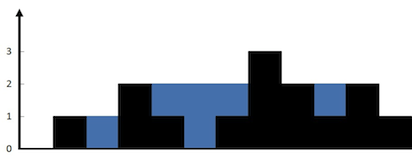LeetCode解题报告—— Trapping Rain Water
Given n non-negative integers representing an elevation map where the width of each bar is 1, compute how much water it is able to trap after raining.

The above elevation map is represented by array [0,1,0,2,1,0,1,3,2,1,2,1]. In this case, 6 units of rain water (blue section) are being trapped. Thanks Marcosfor contributing this image!
Example:
Input: [0,1,0,2,1,0,1,3,2,1,2,1]
Output: 6
思路
Approach 1: Brute force
可以使用暴力破解的方法,即遍历所有的可能,从左往右遍历数组中的每个元素,找每个元素它左边最高的的高度max_left和它右边最高的高度max_right。计算这部分所能trap的水量,也就是max_left和max_right中的最小值减去这个元素的高度。换而言之,这种遍历的方法是遍历求每个横坐标单位上所能trap住的water,即 在这个单位横坐标上所能trap的water减去这个单位上竖条所占的面积:

代码:
class Solution {
public int trap(int[] height) {
int water=0;
for(int i=0;i<height.length;i++){
int max_left=0;
int max_right=0;
for(int j=i;j>=0;j--){
max_left=Math.max(max_left, height[j]);
}
for(int k=i;k<height.length;k++){
max_right=Math.max(max_right, height[k]);
}
water=water+Math.min(max_right, max_left)-height[i];
}
return water;
}
}
Approach 2: Dynamic Programming
方法一种会重复计算左边的max_left和右边的max_right,可以考虑使用dp的方法将已计算的结果存起来避免重复计算的问题。基本想法就是维持两个数组 left_max[i] 和right_max[i],分别存放位置i左边的最大高度和右边的最大高度,然后在再遍历一边数组元素即可。
具体的计算是这样的,对于right_max[i],如果i的高度比right_max[i-1]要高,也就是说位置i的bar的高度比之前高,那么right_max[i]等于height[i],否则就是之前最高的高度,也就是right_left[i-1],计算right_max同理。
代码:
class Solution {
public int trap(int[] height) {
int ans=0;
if(height==null || height.length==0) return ans;
int size=height.length;
int[] left_max=new int[size];
int[] right_max=new int[size];
left_max[0]=height[0];
right_max[size-1]=height[size-1];
for(int i=1;i<size;i++){
left_max[i]=Math.max(left_max[i-1], height[i]);
}
for(int i=size-2;i>=0;i--){
right_max[i]=Math.max(right_max[i+1], height[i]);
}
for(int i=0;i<size;i++){
ans+=Math.min(left_max[i], right_max[i])-height[i];
}
return ans;
}
}
Approach 3: Using stacks
方法三利用栈,遍历整个数组元素,如果当前bar的高度不大于栈顶的bar的高度(也就是不大于上一个bar),那么僵当前bar的索引加入到栈中。如果当前bar的高度大于栈顶bar的高度,可以的出一个结论是栈顶bar 是被当前 bar 和栈顶的前一个bar 困住的(bounded),所以我们能够弹出栈顶的bar并计算这个位置上所能trap的water。弹出栈顶计算完后,再判断当前current是否还是大于新的栈顶bar的高度,如果小于或等于则push入栈,否则继续按之前的执行。注意的是这种计算方法和解法一,解法二的本质不同在于,这个并不是按照单条bar来一个一个计算的,他是先判断两个bar构成的区域再乘以两个bar之间的距离这样来计算的,本质上是两种思路。
代码:
class Solution {
public int trap(int[] height) {
int ans=0;
if(height==null ) return ans;
Stack<Integer> st=new Stack();
int current=0;
while(current<height.length){
while(!st.isEmpty() && height[current]>height[st.peek()]){
int middle=st.peek();
st.pop();
if(st.isEmpty())
break;
int distance=current-st.peek()-1;// 算的是间隔距离,所以要减一
int bounded_height=Math.min(height[current], height[st.peek()])-height[middle];// 标记1
ans+=distance*bounded_height;
}
st.push(current++);
}
return ans;
}
}
标记1处开始看的时候不明白为什么要减去height[middle],其实想到(1)数组中有高度为0的bar也会被添加到栈中 (2)bar之间彼此临接。想到这两中情形的话就好理解多了。
还有Approach 4: Using 2 pointers方法,详细见:https://leetcode.com/problems/trapping-rain-water/solution/
LeetCode解题报告—— Trapping Rain Water的更多相关文章
- [Leetcode][Python]42: Trapping Rain Water
# -*- coding: utf8 -*-'''__author__ = 'dabay.wang@gmail.com' 42: Trapping Rain Waterhttps://oj.leetc ...
- 【LeetCode】42. Trapping Rain Water
Trapping Rain Water Given n non-negative integers representing an elevation map where the width of e ...
- 【一天一道LeetCode】#42. Trapping Rain Water
一天一道LeetCode系列 (一)题目 Given n non-negative integers representing an elevation map where the width of ...
- 【LeetCode】42. Trapping Rain Water 接雨水 (C++)
作者: 负雪明烛 id: fuxuemingzhu 个人博客:http://fuxuemingzhu.cn/ 目录 题目描述 题目大意 解题方法 暴力求解 保存左右最大值 单调栈 日期 题目地址:ht ...
- leetcode problem 42 -- Trapping Rain Water
Given n non-negative integers representing an elevation map where the width of each bar is 1, comput ...
- LeetCode OJ 42. Trapping Rain Water
Given n non-negative integers representing an elevation map where the width of each bar is 1, comput ...
- 【LeetCode】042 Trapping Rain Water
题目: Given n non-negative integers representing an elevation map where the width of each bar is 1, co ...
- LeetCode: Trapping Rain Water 解题报告
https://oj.leetcode.com/problems/trapping-rain-water/ Trapping Rain WaterGiven n non-negative intege ...
- leetCode 42.Trapping Rain Water(凹槽的雨水) 解题思路和方法
Trapping Rain Water Given n non-negative integers representing an elevation map where the width of e ...
随机推荐
- bzoj1483: [HNOI2009]梦幻布丁(链表+启发式合并)
题目大意:一个序列,两种操作. ①把其中的一种数修改成另一种数 ②询问有多少段不同的数如1 2 2 1为3段(1 / 2 2 / 1). 昨晚的BC的C题和这题很类似,于是现学现写居然过了十分开心. ...
- 20181022 考试记录&高级数据结构
题目 W神爷的题解 高级数据结构 T1: 其实是一道easy题,$O(n^3log n)$ 也是能卡过去的,本着要的70分的心态,最后尽然A了. 如果是正解则是$O(n^3)$,当确定你要选择的列时, ...
- Linux系统通过AWS命令行上传文件至S3
打开你的AWS控制台: 在IAM中创建一个新用户(比如test),创建时它会自动创建一个用户安全凭证,是由“访问密钥ID”和“私有访问密钥”组成的,请记住它并下载该凭证,后面会用到它: 选择你刚创建的 ...
- HDU 2852 主席树
KiKi's K-Number Time Limit: 4000/2000 MS (Java/Others) Memory Limit: 32768/32768 K (Java/Others)T ...
- Codeforces Round #544 (Div. 3) 题解
Codeforces Round #544 (Div. 3) D. Zero Quantity Maximization 题目链接:https://codeforces.com/contest/113 ...
- POJ 3111 二分
K Best Time Limit: 8000MS Memory Limit: 65536K Total Submissions: 10507 Accepted: 2709 Case Time ...
- 【c#】winform 上传图片
1.拖拽上传图片 1.1.后台代码中修改窗体属性,添加 AllowDrop = true 1.2.给窗体添加拖拽事件,在事件列表找到拖拽 双击即可: 在 DragDrop 生成的方法中添加代码如下: ...
- 图论&数学:矩阵树定理
运用矩阵树定理进行生成树计数 给定一个n个点m条边的无向图,问生成树有多少种可能 直接套用矩阵树定理计算即可 矩阵树定理的描述如下: 首先读入无向图的邻接矩阵,u-v G[u][v]++ G[v][u ...
- [Luogu 2590] ZJOI2008 树的统计
[Luogu 2590] ZJOI2008 树的统计 裸树剖不解释. 比板子还简单. #include <algorithm> #include <cstdio> #inclu ...
- EntitySpace 常用语句
EntitySpace 这个是很早期的ORM框架,最近发现这个破解的也都不能用了.有谁知道能用的,联系我. 1. where带几个条件的 query.Where(query.ProductTempSt ...
